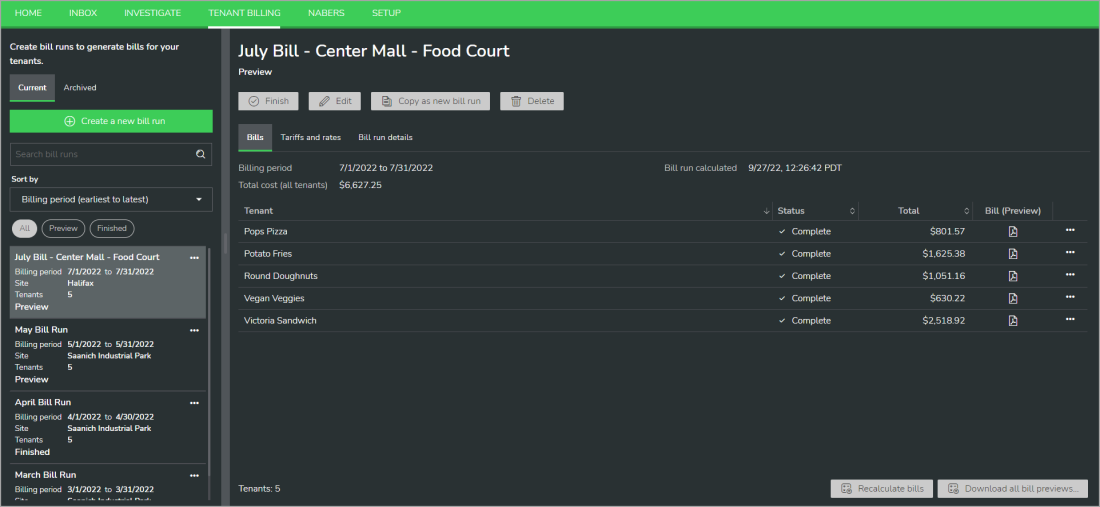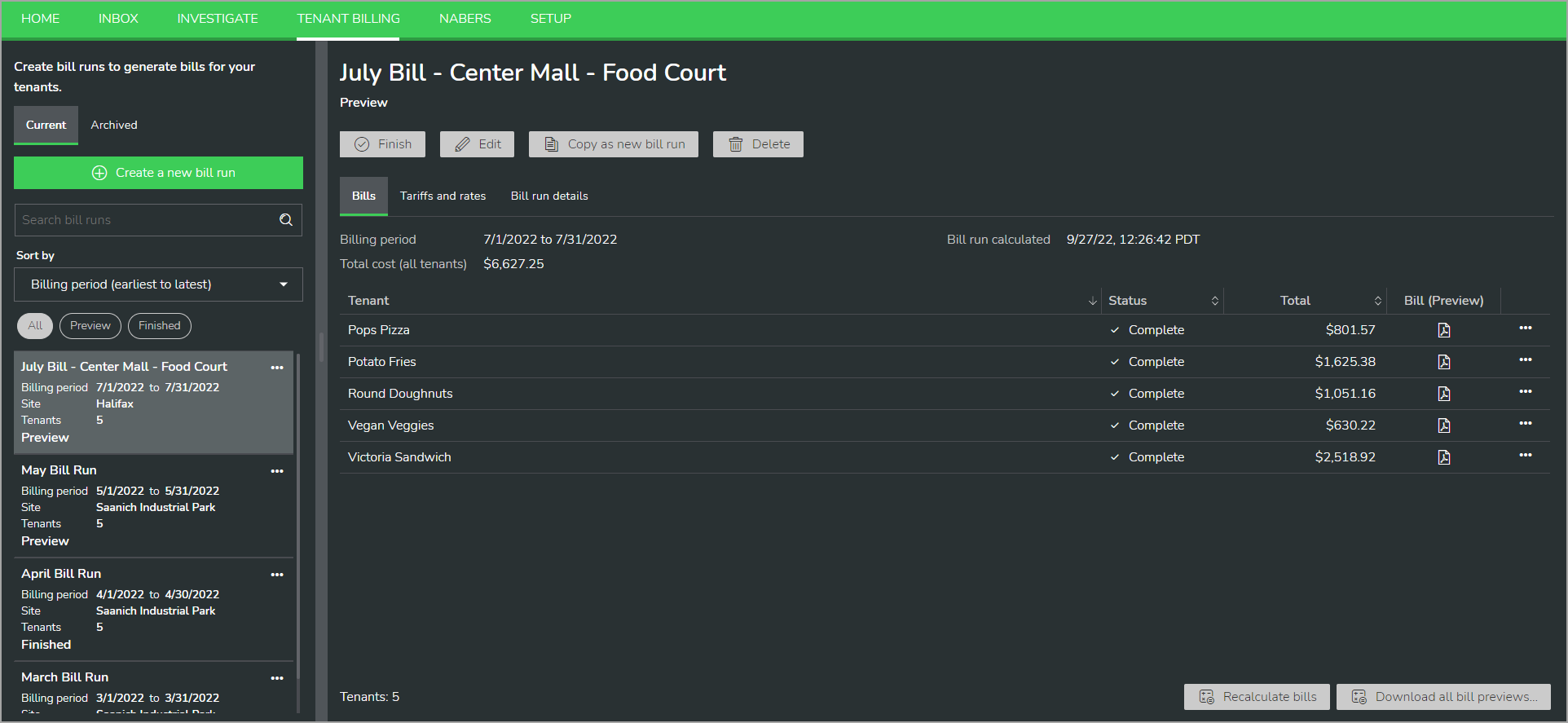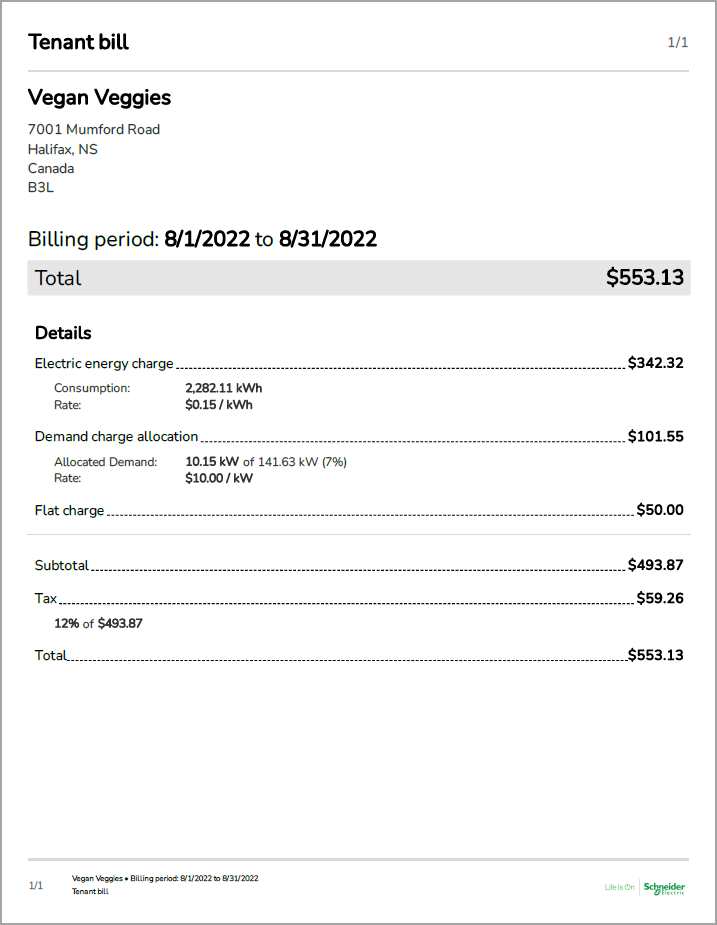Tenant billing
NOTE: The functionality displayed in this topic might not be the same as what you see for your organization. Your Energy Hub feature plan subscription determines what functionality is available for this feature. For feature plan details, see Feature plans.
Overview
Allocate costs and generate tenant bills for electrical energy consumption.
Features
[Web app only]
Tenant energy billing allocates costs and generates bills for building tenants based on sub-metered electrical energy consumption. You can set the billing period and tariff, select the tenants, and generate individual tenant bills. Tenant energy billing also keeps a record of previous bill runs for future reference.
- Tenant billing is only for electricity, not for water or gas.
- Tenant billing supports up to 500 tenants.
Tariffs
NOTE: You cannot use the tariffs defined in Investigate > Cost view with Tenant energy billing.
Tenant energy billing supports a basic tariff. The basic tariff includes the following charges:
| Charge | Description | Example (*) |
|---|---|---|
|
Electric energy charge |
The electric energy charge is based on the tenant's energy consumption for the billing period. Electric energy charge = (tenant kWh) × (energy rate) |
Electric energy charge = 100 kWh × $0.2/kWh = $20 |
|
Demand charge |
The demand charge allocates demand costs based on the tenant's energy consumption relative to the total energy consumption of the site for the billing period. Demand charge = (tenant kWh/site kWh) × (site peak kW) × (demand rate) NOTE: If demand measurements are not available from one or more devices at a location, then Energy Hub uses power measurements instead of demand from these devices to calculate the demand charge. |
Demand charge = (100 kWh/200 kWh) × 5 kW × $10/kW = $25 |
|
Fixed charge |
The fixed charge covers expenses such as fees related to metering, billing, and payment processing. |
Fixed charge = $5 |
|
Tax |
The tax charge covers applicable local or state taxes. |
Tax = 12% |
(*) The example is based on the following rates and consumption values: Tenant kWh = 100 kWh; Site kWh = 200 kWh; Site kW peak = 5 kW; Electric energy rate = $0.2/kWh; Demand rate = $10/kW
Tenant energy billing includes the following data:
- Electric energy consumption
- Electric energy consumption cost
There are no software-based alarm types for Tenant energy billing. To learn more about alarming in Energy Hub, see Alarming.
Prerequisites
Verify that:
- You have an active Energy Hub subscription that includes this feature. For information on subscriptions, see Energy Hub subscriptions.
- Power monitoring devices are installed in your facility to monitor loads such as lighting, air conditioning, plug loads, and other consumers.
- The monitoring devices are connected to communication gateways, for example Site Server or Panel Server, that are sending measurement data to Energy Hub over the internet.
- The communication gateways have been added to your organization in Energy Hub.
- An organization model has been set up in Energy Hub, defining the sites, buildings, and other locations that are sub-metered and occupied by tenants.
- Loads and supplies have been configured and usage types have been assigned for the tenant locations.
Configuration
Create tenants and assign them to their sub-metered locations. You can create up to 500 tenants.
For step-by-step instructions on this configuration task, see tenant energy billing tasks.
Generating bills
To generate tenant bills, you need to create a bill run. A bill run generates tenant bills based on a list of tenants, a tariff, and a billing period.
Finishing bill runs
Finishing a bill run closes it for edits and preserves it for future reference. Finish a bill run preview before generating the final tenant bills.
Sending bills to tenants
Energy Hub generates tenant bills, but it does not send them out to your tenants. To send bills to your tenants, download the bills and then use your preferred method of communicating with your tenants, such as email, to send them.
Archiving finished bill runs
The navigation panel in the bill run manager has two views (or folders) that you can use to organize your finished bill runs. By default, Energy Hub saves newly created bill runs and bill run previews to the Current view. To keep the Current view uncluttered, you can manually move old and obsolete bill runs to the Archived view. You can also move bill runs from the Archived view back to the Current view.
For step-by-step instructions on tenant energy billing operation, see tenant energy billing tasks.
You can view and manage tenant bills in the bill run manager, in Tenant Billing. For step-by-step instructions on how to view tenant energy billing, see viewing tenant energy billing.
Tenant billing UI example (shown in dark mode):


You can download tenant bills in PDF format. For step-by-step instructions on how to report on tenant energy billing, see Reporting tasks.
 warning
warning